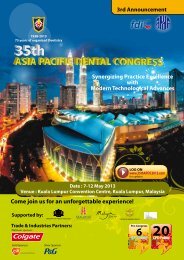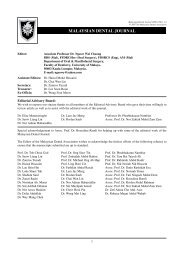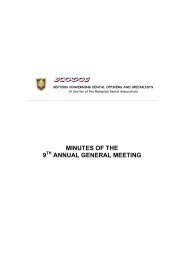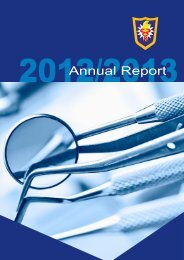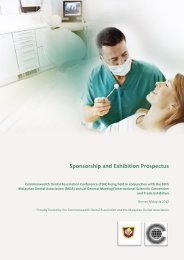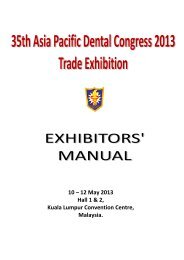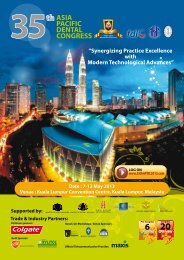PDF( 8mb) - Malaysian Dental Association
PDF( 8mb) - Malaysian Dental Association
PDF( 8mb) - Malaysian Dental Association
Create successful ePaper yourself
Turn your PDF publications into a flip-book with our unique Google optimized e-Paper software.
Shamsher / PhrabhakaranCASE 2: Ray KroneOn 29 December 1991, a cocktail waitress, KimAncona, was found dead in the men’s restroom at a loungein Phoenix, US. 12-14 A post-mortem examination of thebody revealed that she had been stabbed 11 times and herleft breast had been bitten through the tank-top that shewas wearing at that time. There were neither fingerprintsnor semen found on her. The police immediately arrestedRay Krone, a former US Air Force mailman, based on thefacts that he had been a regular customer at the loungewhere Ancona was working and had known her personally.From the day of his arrest, however, Krone maintained hisinnocence. The only proof against him was the evidenceof a forensic odontologist, Dr. Raymond Rawson, whotestified that the bitemark on the victim’s breast matchedwith Krone’s dentition (Fig. 5). The jury was convincedwith the testimony of Dr. Rawson and found Krone guiltyof first degree murder. The trial court sentenced him todeath but due to some other legal reasons, the convictionwas regarded as unsafe and a re-trial was ordered. Twoyears after waiting on the death row, Krone was againfound guilty at the re-trial but the sentence was reducedto life imprisonment. Eight years later, a permission toconduct a DNA (deoxyribonucleic acid) test on the salivadeposited on Ancona’s tank-top was granted. Shockingly,the test revealed that Krone was not the attacker. Afterspending a total of 10 years in jail, Krone was finallyacquitted. Maricopa County Attorney, Rick Romley, madea public apology to Krone and the US government pledgedto compensate him for his losses. 12-14Figure 5: A photograph showing how the forensicodontologist in this case found a positive match betweenthe disputed bitemark and the dental features of theaccused. © Dr. Michael Bowers, http://forensic.to/webhome/bitemarks1. (Used by permission)Being unhappy with that conclusion, Torgersen demandedthat the bitemark and his dentition should be re-examinedby another expert and Professor Dr. Jens Wærhaug was thencalled for such purpose. Without consulting Dr. Strøm orreferring to his findings, Professor Dr. Wærhaug reached toa similar conclusion. Torgersen was subsequently chargedat the Norwegian Crown Court in 1958, where at the endof the trial, he was found guilty and sentenced to prison.Norwegian Supreme Court dismissed his appeal butshortly before Torgersen’s release from the prison in 1974,his application to re-open the case was allowed. The courtthen appointed another forensic odontologist, ProfessorDr. Gisle Bang to shed some light on the matter underenquiry. He re-evaluated all the evidence and used moderncomparison methods like the scanning electron microscopyand a stereometric plotting technique. Expectedly, hisconclusion supported the earlier findings. However in1998, Torgersen’s private dentist reported that Torgersencould not have produced the bitemark and as a result, afurther appeal to re-open the case was made. A year later,it was granted and two experts, Professor Dr. GordonMacDonald and Dr. David Whittaker, were consulted.After evaluating all the evidence available, they concurredwith the findings made by the three forensic odontologistsearlier. Despite five leading experts’ opinions against him,Torgersen still maintained that he is innocent. 15-17 In 2001,Dr. Michael Bowers independently examined the evidenceof this case and astonishingly, he found that Torgersen didnot produce the disputed bitemark. He made the followingsubmission:I exclude Mr. Torgersen as the creator of thisbitemark. My opinion is that there is considerable forensicevidence that creates reasonable doubt that Mr. Torgersencreated the bitemark on the deceased’s body. The physicalevidence I have seen does not convince me that the State’sargument of a positive identification is correct. In fact, Iconclude that the State’s argument is an excellent exampleof a false positive identification. 18Figure 6: A photograph showing a partial bitemarkbelow the left nipple of a murdered victim. © Dr.Michael Bowers,http://forensic.to/webhome/bitemarks2/Image2.gif.(Used by permission)CASE 3: Fredrik TorgersenIn 1957, a 16-year old girl was sexually harassedand murdered in Norway. 15-17 During the postmortemexamination, an injury consistent with a partial humanbitemark was discovered below her left nipple (Fig. 6).The police arrested Fredrik Torgersen near the crime scenearea, based on his previous criminal records which includea conviction for the offence of attempted rape. Forensicodontologist, Dr. Ferdinand Strøm, then compared thebitemark with Torgersen’s dentition and concluded that itis highly likely that Torgersen had produced the bitemark.121



